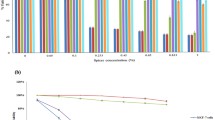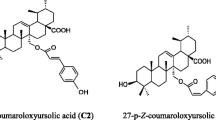Abstract
Purpose
Several recently published data suggest that the anti-proliferative and pro-apoptotic properties of hydroxytyrosol [3,4-dihydroxyphenyl ethanol (3,4-DHPEA)] on HL60 cells may be mediated by the accumulation of hydrogen peroxide (H2O2) in the culture medium. The aim of this study was to clarify the role played by H2O2 in the chemopreventive activities of 3,4-DHPEA on breast (MDA and MCF-7), prostate (LNCap and PC3) and colon (SW480 and HCT116) cancer cell lines and to investigate the effects of cell culture medium components and the possible mechanisms at the basis of the H2O2-producing properties of 3,4-DHPEA.
Methods
The proliferation was measured by the MTT assay and the apoptosis by both fluorescence microscopy and flow cytometry. The concentration of H2O2 in the culture medium was measured by the ferrous ion oxidation–xylenol orange method.
Results
It was found that the H2O2-inducing ability of 3,4-DHPEA is completely prevented by pyruvate and that the exposure of cells to conditions not supporting the H2O2 accumulation (addition of either catalase or pyruvate to the culture medium) inhibited the anti-proliferative effect of 3,4-DHPEA. Accordingly, the sensitivity of the different cell lines to the anti-proliferative effect of 3,4-DHPEA was inversely correlated with their ability to remove H2O2 from the culture medium. With regard to the mechanism by which 3,4-DHPEA causes the H2O2 accumulation, it was found that superoxide dismutase increased the H2O2 production while tyrosinase, slightly acidic pH (6,8) and absence of oxygen (O2) completely prevented this activity. In addition, different transition metal-chelating compounds did not modify the H2O2-producing activity of 3,4-DHPEA.
Conclusions
The pro-oxidant activity of 3,4-DHPEA deeply influences its ‘in vitro’ chemopreventive activities. The main initiation step in the H2O2-producing activity is the auto-oxidation of 3,4-DHPEA by O2 with the formation of the semiquinone, superoxide ions (O2 −) and 2H+.




Similar content being viewed by others
References
Babich H, Liebling EJ, Burger RF, Zuckerbraun HL, Schuck AG (2009) Choice of DMEM, formulated with or without pyruvate, plays an important role in assessing the in vitro cytotoxicity of oxidants and prooxidant nutraceuticals. In Vitro Cell Develop Biol 45:226–233
Bernini R, Crisante F, Merendino N, Molinari R, Soldatelli MC, Velotti F (2011) Synthesis of a novel ester of hydroxytyrosol and α-lipoic acid exhibiting an antiproliferative effect on human colon cancer HT-29 cells. Eur J Med Chem 46:439–446
Cambon-Roques S, Landrault N, Teissèdre PL, Laurent C, Besançon P, Rouanet JM, Caporiccio B (2002) Hydrogen peroxide generation in Caco-2 cell culture medium by addition of phenolic compounds: effect of ascorbic acid. Free Rad Res 36:593–599
Chai CP, Long HL, Halliwell B (2003) Contribution of hydrogen peroxide to the cytotoxicity of green tea and red wines. Biochem Biophys Res Comm 304:650–654
Cornwell DG, Ma J (2008) Nutritional benefit of olive oil: the biological effect of hydroxytyrosol and its arylatin quinone adducts. J Agric Food Chem 56:8774–8786
Corona G, Xenofon T, Dessi MA, Deiana M, Debnam ES, Visioli S, Spencer JPE (2006) The fate of olive oil polyphenols in the gastrointestinal tract: implication of gastric and colonic microflora-dependent biotransformation. Free Rad Res 40:647–658
Corona G, Deiana M, Incani A, Vauzour D, Dessì MA, Spencer JP (2009) Hydroxytyrosol inhibit the proliferation of human colon adenocarcinoma cells through inhibition of ERK1/2 and cyclin D1. Mol Nutr Food Res 53:897–903
Covas MI, de la Torre K, Farré-Albaladejo M, Kaikkonen J, Fitó M, López-Sabater C, Pujadas-Bastardes MA, Joglar J, Weinbrenner T, Lamuela-Raventós RM, de la Torre R (2005) Postprandial LDL phenolic content and LDL oxidation are modulated by olive oil phenolic compounds in humans. Free Radic Biol Med 40:608–616
D’Angelo S, Ingrosso D, Migliardi V, Sorrentino A, Donnarumma G, Baroni A, Masella L, Tufano MA, Zappia M, Galletti P (2005) Hydroxytyrosol, a natural antioxidant from olive oil, prevents protein damage induced by long-wave ultraviolet radiation in melanoma cells. Free Rad Biol Med 38:908–919
de la Torre R (2008) Bioavailability of olive oil phenolic compounds in humans. Inflammopharmacol 16:1–3
Della Ragione FD, Cucciolla V, Borriello A, Pietra VD, Pontoni G, Racioppi L, Manna C, Galletti P, Zappia V (2000) Hydroxytyrosol, a natural molecule occurring in olive oil, induces cytochrome c-dependent apoptosis. Biochem Biophys Res Comm 278:733–739
Espín JC, Soler-Rivas C, Cantos E, Tomás-Barberán FA, Wichers HJ (2001) Synthesis of the antioxidant hydroxytyrosol using tyrosinase as biocatalyst. J Agric Food Chem 49:1187–1193
Fabiani R, De Bartolomeo A, Rosignoli P, Servili M, Montedoro GF, Morozzi G (2002) Cancer chemoprevention by hydroxytyrosol isolated from virgin olive oil through G1 cell cycle arrest and apoptosis. Eur J Cancer Prev 11:351–358
Fabiani R, Rosignoli P, De Bartolomeo A, Fuccelli R, Morozzi G (2008) Inhibition of cell cycle progression by hydroxytyrosol is associated with the up-regulation of CDK inhibitors p21WAF1/Cip1 and p27Kip1 and with the induction of differentiation in HL60 cells. J Nutr 138:42–48
Fabiani R, Rosignoli P, De Bartolomeo A, Fuccelli R, Servili M, Montedoro GF, Morozzi G (2008) Oxidative DNA damage is prevented by extracts of olive oil, hydroxytyrosol and other olive phenolic compounds in human blood mononuclear cells and HL60 cells. J Nutr 138:1411–1416
Fabiani R, Fuccelli R, Pieravanti F, De Bartolomeo A, Morozzi G (2009) Production of hydrogen peroxide is responsible for then induction of apoptosis on HL60 cells. Mol Nutr Food Res 53:887–896
Foreman BD, Tarloff JB (2008) Contribution of reactive oxygen species to para-aminophenol toxicity in LLC-PK1 cells. Toxicol Appl Pharmacol 230:144–149
Guichard C, Pedruzzi E, Fay M, Marie JC, Braut-Boucher F, Daniel F, Grodet A, Gougerot-Pocidalo MA, Chastre E, Kotelevets L, Lizard G, Vandewalle A, Driss F, Ogier-Denis E (2006) Dihydroxyphenylethanol induces apoptosis by activating serine/threonine protein phosphatase PP2A and promotes the endoplasmic reticulum stress response in human colon carcinoma cells. Carcinogenesis 27:1812–1827
Goulas V, Exarchou V, Troganis AN, Psomiadou E, Fotsis T, Briasoulis E, Gerothanassis P (2009) Phytochemicals in olive oil-leaf extracts and thei antiproliferative activity against cancer and endothelial cells. Mol Nutr Food Res 53:600–608
Han J, Talorete TPN, Yamada P, Isoda H (2009) Anti-proliferative and apoptotic effects of oleuropein and hydroxytyrosol on human breast cancer MCF-7 cells. Cytotechnology 59:45–53
Hashim YZ, Eng M, Gill CI, McGlynn H, Rowland IR (2005) Components of olive oil and chemoprevention of colorectal cancer. Nutr Rev 63:374–386
Hiramoto K, Kida T, Kikugawa K (2002) Increases urinary hydrogen peroxide level caused by coffee drinking. Biol Pharm Bull 25:1467–1471
Hoorens A, Van de Casteele M, Klöppel G, Pipeleers D (1996) Glucose promotes survival of rat pancreatic beta cells by activating synthesis of proteins which suppress a constitutive apoptotic program. J Clin Invest 98:1568–1574
Hussain RF, Nouri AM, Oliver RT (1993) A new approach for measurement of cytotoxicity using colorimetric assay. J Immunol Methods 160:89–96
Lapidot T, Walker MD, Kanner J (2002) Can apple antioxidants inhibit tumor cell proliferation? Generation of H2O2 during interaction of phenolic compounds with the cell culture media. J Agric Food Chem 50:3156–3160
Lee WK, Hur HJ, Lee JH, Lee CY (2005) Antiproliferative effects of dietary phenolic substances and hydrogen peroxide. J Agric Food Chem 53:1990–1995
Liochev SI, Fridovich I (2007) The effects of superoxide dismutase on H2O2 formation. Free Rad Biol Med 42:1465–1469
Long LH, Kirkland D, Whitwell J, Halliwell B (2007) Different cytotoxic and clastogenic effects of epigallocathechin gallate in various cell-culture media due to variable rates of its oxidation in the cell culture medium. Mutat Res 634:177–183
Menendez JA, Vazquez-Martin A, Colomer R, Brunet J, Carrasco-Pacombo A, Garcia-Villalba R, Fernandez-Gutierrez A, Segua-Carretero A (2007) Olive oil’s bitter principle reverses acquired autoresistance to trastuzumab (Herceptin) in HER2-overexpressing breast cancer cells. BMC Cancer 7:80
Miro-Casas E, Covas MI, Farre M, Fito M, Ortuño J, Weinbrenner T, Roset P, de la Torre R (2003) Hydroxytyrosol disposition in humans. Clin Chem 49:945–952
Miura YH, Tomita I, Watanabe T, Hirayama T, Fuku S (1998) Active oxygen generation by flavonoids. Biol Pharm Bull 21:93–96
Mochizuki M, Yamazaki S, Kano K, Ikeda T (2002) Kinetic analysis and mechanistic aspects of autoxidation of catechins. Biochim Biophys Acta 1569:35–44
Nakagawa H, Hasumi K, Woo JT, Nagai K, Wachi M (2004) Generation of hydrogen peroxide primarily contributes to the induction of Fe(II)-dependent apoptosis in Jurkat cells by (−)-epigallocatechin gallate. Carcinogenesis 29:1567–1574
Nourooz-Zadeh J, Tajaddini-Sarmadi J, Wolff SP (1994) Measurement of plasma hydroperoxide concentration by the ferrous oxidation-xylenol orange assay in conjunction with triphenylphosphine. Anal Biochem 220:403–409
Obied HK, Prenzler PD, Konczak I, Rehman A, Robards K (2009) Chemistry and bioactivity of olive biophenols in some antioxidant and antiproliferative in vitro bioassay. Chem Res Toxicol 22:227–234
O’Dowd Y, Driss F, My-Chan Dang P, Albim C, Gougerot-Pocidalo MA, Pasquier C, El-Benna J (2004) Antioxidant effect of hydroxytyrosol, a polyphenol from olive oil: scavenging of hydrogen peroxide but not superoxide anion produced by human neutrophils. Biochem Pharmacol 68:2003–2008
Rietjens SJ, Bast A, Haenen GR (2007) New insights into controversies on the antioxidant potential of the olive oil antioxidant hydroxytyrosol. J Agric Food Chem 55:7609–7614
Sakihama Y, Cohen MF, Grace SC, Yamasaki H (2002) Plant phenolic antioxidant and prooxidant activities: phenolic-induced oxidative damage mediated by metals in plants. Toxicology 177:67–80
Schuck AG, Ausubel MB, Zuckerbraun HL, Babich H (2008) Theaflavin-3, 3′-digallate, a component of black tea: an induced of oxidative stress and apoptosis. Toxicol In Vitro 22:598–609
Servili M, Montedoro GF (2002) Contribution of phenolic compounds to virgin olive oil quality. Eur J Lipid Sci Technol 104:602–613
Sirianni R, Chimento A, De Luca A, Casaburi I, Rizza P, Onofrio A, Iacopetta D, Puoci F, Andò S, Maggiolini M, Pezzi V (2010) Oleuropein and hydroxytyrosol inhibit MCF-7 breast cancer cells proliferation interfering with ERK1/2 activation. Mol Nutr Food Res 54:833–840
Visioli F, Bellomo G, Galli C (1998) Free radical-scavenging properties of olive oil polyphenols. Biochem Biophys Res Comm 247:64
Vissers MN, Zock PL, Katan MB (2004) Bioavailability and antioxidant effects of olive oil phenols in humans: a review. Eur J Clin Nutr 58:955–965
Wee LM, Long LH, Whiteman M, Halliwell B (2003) Factors affecting the ascorbate- and phenolic-dependent generation of hydrogen peroxide in Dulbecco’s modified Eagles Medium. Free Rad Res 37:1123–1130
Acknowledgments
This work was supported by grants of the MIUR, FISR ‘Bando 2002, Qualità Alimentare e Benessere’.
Author information
Authors and Affiliations
Corresponding author
Rights and permissions
About this article
Cite this article
Fabiani, R., Sepporta, M.V., Rosignoli, P. et al. Anti-proliferative and pro-apoptotic activities of hydroxytyrosol on different tumour cells: the role of extracellular production of hydrogen peroxide. Eur J Nutr 51, 455–464 (2012). https://doi.org/10.1007/s00394-011-0230-3
Received:
Accepted:
Published:
Issue Date:
DOI: https://doi.org/10.1007/s00394-011-0230-3




